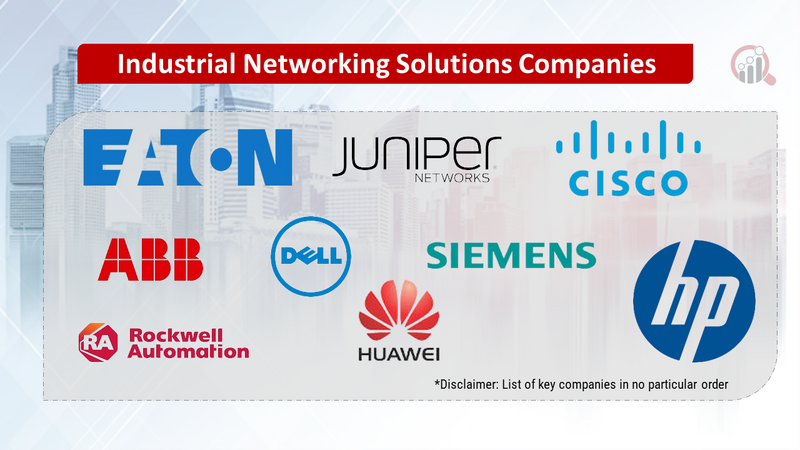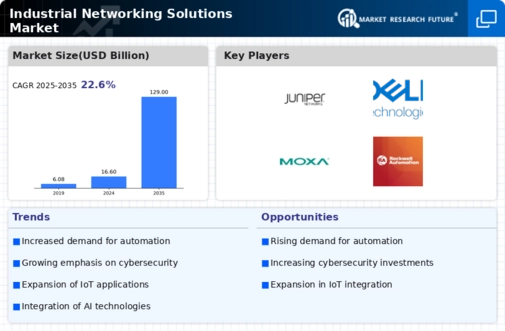Top Industry Leaders in the Industrial Networking Solutions Market

Industrial Networking Solutions Market: Dive into the Latest News and Updates
The industrial landscape is undergoing a digital transformation, driven by automation, data-driven decision-making, and interconnected systems. At the heart of this revolution lies the Industrial Networking Solutions Market, a rapidly expanding sector powering the seamless flow of information and intelligent operations across factories, power grids, and transportation networks.
Some of Industrial Networking Solution Companies Listed Below:
- Siemens AG (German)
- Cisco Systems Inc. (US)
- Juniper Networks (US)
- Dell Inc. (US)
- Moxa Inc. (US)
- ABB (Switzerland)
- Eaton (Ireland)
- Huawei Technologies Co. Ltd (China)
- Rockwell Automation Inc. (US)
- Hewlett Packard Enterprise Development LP (US)
Strategies Driving Market Growth:
-
Focus on Connectivity and Interoperability: Providing solutions that connect diverse industrial devices, sensors, and systems with seamless interoperability across different protocols and platforms is crucial for efficient data exchange and unified operations. -
Security and Resilience: Offering robust security features and built-in redundancy guarantees reliable and secure data transmission, safeguarding critical infrastructure and protecting against cyberattacks. -
Data-Driven Insights and Analytics: Industrial networking solutions integrated with data analytics platforms empower businesses to gain insights from operational data, optimize processes, and make informed decisions based on real-time information. -
Cloud-Based Management and Scalability: Providing cloud-based platforms for network management and data analysis simplifies operations, enables remote monitoring, and offers flexible scalability for evolving industrial needs.
Market Share Decoding: Key Factors to Consider:
-
Product Portfolio and Application Focus: Companies offering diverse solutions catering to specific industrial applications, such as manufacturing, energy, or transportation, attract larger customer bases and gain market share in niche sectors. -
Openness and Standards Adherence: Adherence to open industry standards for industrial networking ensures compatibility with existing infrastructure and avoids vendor lock-in, attracting a wider range of customers. -
Security Certifications and Data Privacy Compliance: Demonstrating compliance with strict industry security and data privacy regulations builds trust and fosters adoption within critical infrastructure sectors. -
Cost-Effectiveness and Scalability: Affordable solutions offering flexible deployments and scalability cater to diverse budget constraints and accommodate evolving industrial needs, expanding market reach.
New and Emerging Stars: Illuminating the Industrial Networking Path:
-
Edge Computing Solutions: Startups like Fastly and EdgeConneX are developing edge computing platforms and industrial networking solutions optimized for near-real-time data processing and decision-making at the edge of the network, improving operational efficiency and responsiveness. -
5G and Industrial Wireless Technologies: Companies like Qualcomm and Verizon are exploring 5G integration and specialized industrial wireless solutions offering high-speed wireless connectivity, low latency, and reliable communication for remote assets and mobile applications. -
Artificial Intelligence (AI) and Machine Learning (ML) Integration: Startups like Noodle AI and C3.ai are embedding AI and ML capabilities into industrial networking solutions, enabling automated anomaly detection, predictive maintenance, and intelligent process optimization for data-driven industrial operations.
Latest Company Updates:
-
February 7, 2024:-
Growing adoption of edge computing in industrial networks: Processing data closer to the source with smaller, embedded devices reduces latency and improves performance for time-sensitive applications. -
Focus on decentralization and scalability: Edge computing offers flexibility and adaptability for diverse industrial environments.
February 14, 2024:-
Industrial 5G networks rollout begins: Delivering ultra-reliable low-latency communication (uRLLC) for critical industrial applications like automated guided vehicles (AGVs) and remote monitoring. -
Focus on enabling Industry 4.0 advancements: 5G enables real-time data exchange, machine-to-machine communication, and predictive maintenance.
February 21, 2024:-
Security concerns emerge in connected industrial networks: Increased attack surface with connected devices and industrial control systems (ICS) requires robust security measures. -
Focus on zero-trust security and segmentation: Implementing least-privilege access and isolation of critical systems to mitigate threats.
February 28, 2024:-
Artificial intelligence (AI) and machine learning (ML) integrated into industrial networks: Predictive maintenance, anomaly detection, and optimized production processes driven by data analysis. -
Focus on data-driven insights and operational efficiency: AI and ML unlock valuable insights for improving manufacturing processes and resource utilization.
-

